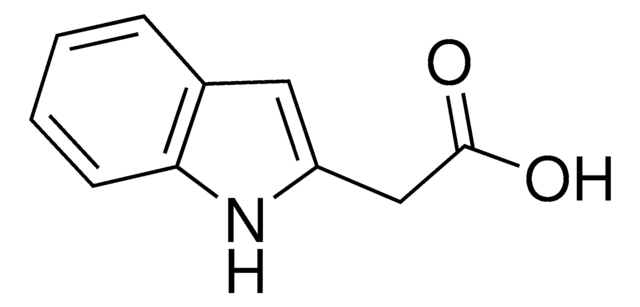I2886
3-Indoleacetic acid
suitable for plant cell culture, crystalline
Synonym(s):
indole acetic acid, Heteroauxin, IAA
About This Item
Recommended Products
Assay
≥98%
Quality Level
form
crystalline
technique(s)
cell culture | plant: suitable
color
white to pink
mp
165-169 °C (lit.)
application(s)
agriculture
storage temp.
−20°C
SMILES string
OC(=O)Cc1c[nH]c2ccccc12
InChI
1S/C10H9NO2/c12-10(13)5-7-6-11-9-4-2-1-3-8(7)9/h1-4,6,11H,5H2,(H,12,13)
InChI key
SEOVTRFCIGRIMH-UHFFFAOYSA-N
Looking for similar products? Visit Product Comparison Guide
Application
- as standard to quantify hormones
- to modify MS (Murashige and Skoog) media for the initiation of callus
- as an external standard in the analyses of free endogenous growth regulators
Preparation Note
Storage Class Code
11 - Combustible Solids
WGK
WGK 3
Flash Point(F)
Not applicable
Flash Point(C)
Not applicable
Personal Protective Equipment
Certificates of Analysis (COA)
Search for Certificates of Analysis (COA) by entering the products Lot/Batch Number. Lot and Batch Numbers can be found on a product’s label following the words ‘Lot’ or ‘Batch’.
Already Own This Product?
Find documentation for the products that you have recently purchased in the Document Library.
Customers Also Viewed
Protocols
Reference guide and preparation guide for antibiotic and antimycotic use in plant tissue culture.
Reference guide and preparation guide for antibiotic and antimycotic use in plant tissue culture.
Reference guide and preparation guide for antibiotic and antimycotic use in plant tissue culture.
Reference guide and preparation guide for antibiotic and antimycotic use in plant tissue culture.
Our team of scientists has experience in all areas of research including Life Science, Material Science, Chemical Synthesis, Chromatography, Analytical and many others.
Contact Technical Service









